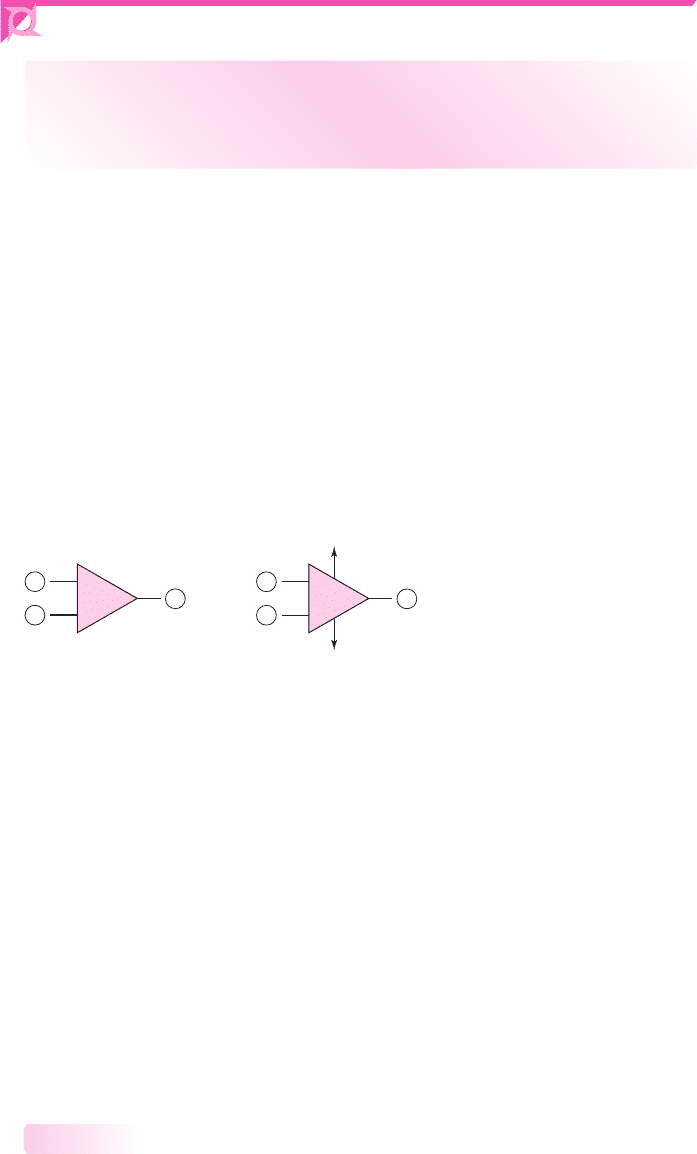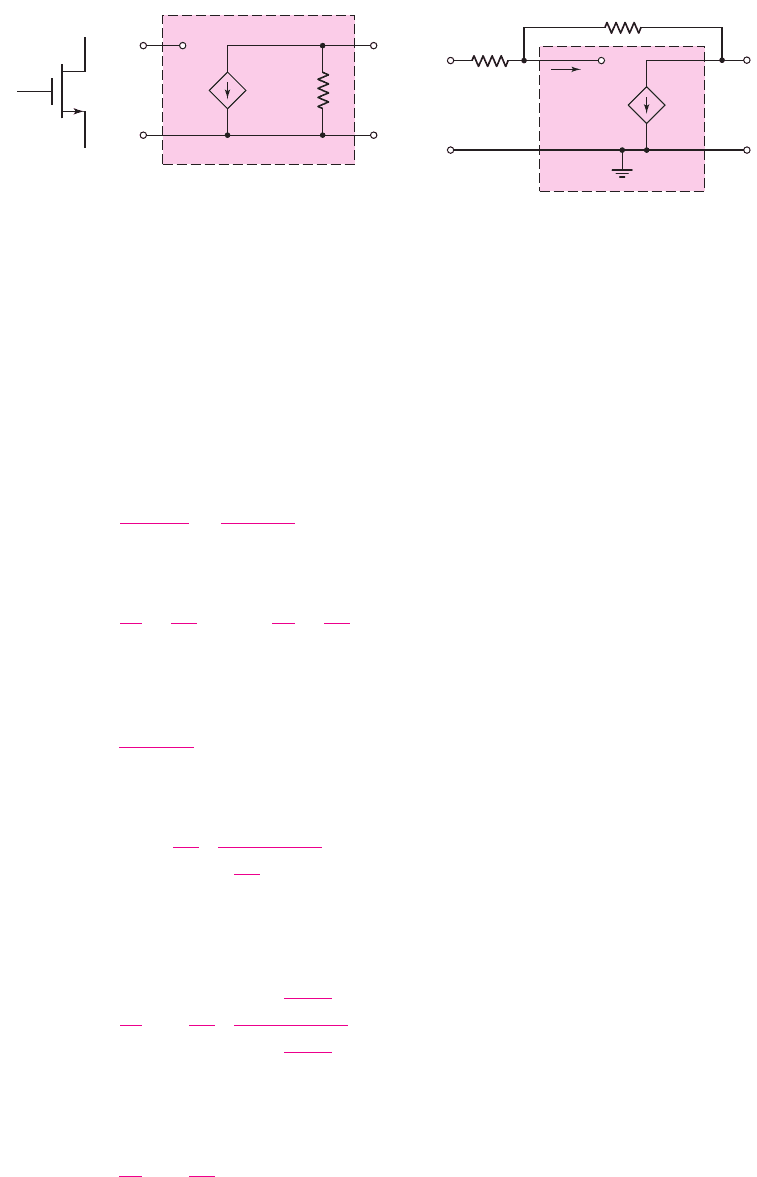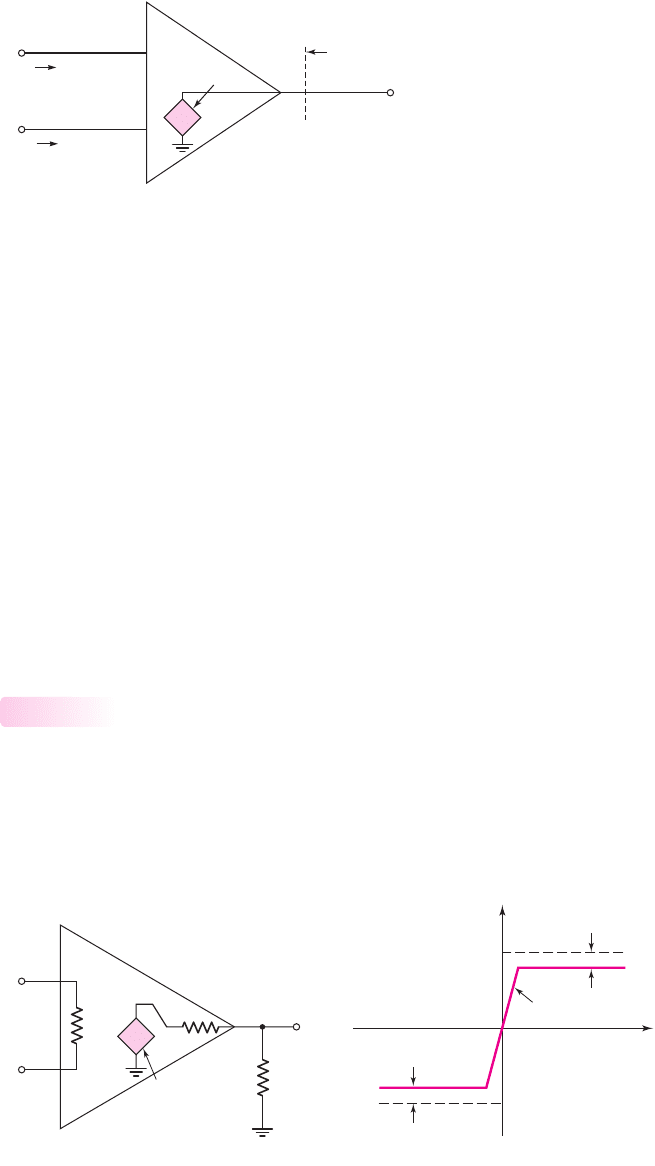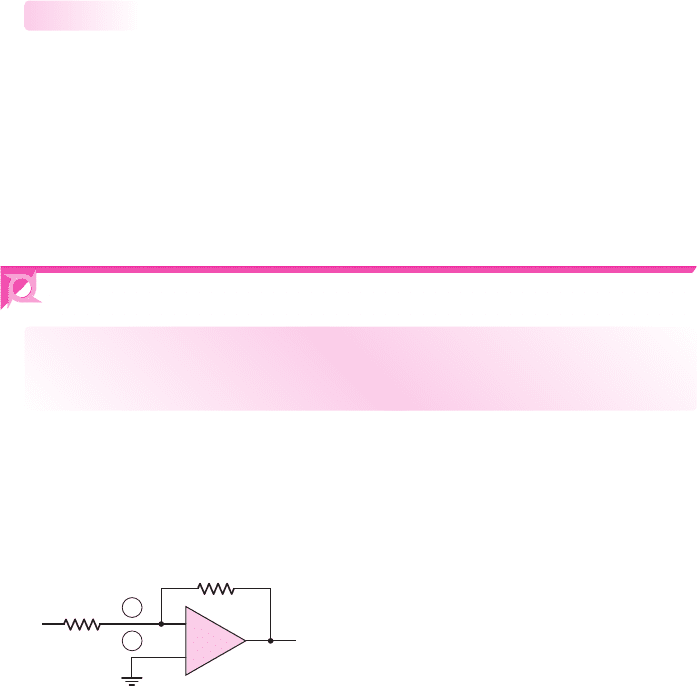Neamen D. Microelectronics: Circuit Analysis and Design
Подождите немного. Документ загружается.

The choice of a temperature transducer is based in part on the required temperature
range. The design of the amplifier begins with the anticipated output signal of the
temperature transducer, which in turn implies a required level of input impedance and
signal gain for the amplifier. The necessary stability of the amplifier gain may deter-
mine whether a simple amplifier design may be used, or a more complex amplifier
using feedback may be necessary. In addition, the location of the amplifier on the
aircraft may determine the temperature range over which the amplifier must function.
The comparator compares the amplifier output, which corresponds to a particular
temperature, to a preset value. If the amplifier output is greater than the preset value, the
output of the comparator must then be able to activate the warning light. The voltage
and current levels required to activate the warning light are determined and are incor-
porated into the design of the comparator.
In proposing the initial circuit configuration and component values, the design
engineer may use an intuitive approach based to a large extent on experience. How-
ever, once this initial design is completed, the design must be verified with a mathe-
matical analysis or computer simulation. The initial design process may include
calculations using simple models for the transistors and circuits. Normally, a more
sophisticated analysis is required to take into account such things as temperature
variations, tolerances in component values, and other parameter variations based on
a particular application.
The circuit performance estimation or simulation is usually a very important
phase of the design process. To validate the final design, it is necessary to simulate,
as precisely as possible, the performance of the discrete devices and ICs used in the
design. Simulation models are required for each circuit component in order to predict
the operation and characteristics of the designed circuits. On the basis of these simu-
lation models, trade-offs between technologies and devices may be evaluated to ob-
tain the optimum performance. With improved simulation models, the breadboard
development stage may be eliminated and the design process may proceed directly to
the construction of a prototype circuit. Since the prototype circuit may involve the
fabrication of specialized or customized integrated circuits, this phase of the design
process may be expensive; therefore, costly mistakes in the design must be avoided.
A good circuit simulation may identify potential problems that can be corrected
before the prototype circuit is fabricated.
The prototype circuit is then tested and evaluated. At this point, a minor redesign
may involve only selecting slightly different component values. A more extensive
redesign may require selecting an entirely different circuit configuration in order to
meet the system requirements. Finally, the entire system is constructed from the
operating subsystems.
CONCLUSION
Design involves creativity, and it can be challenging and rewarding. Design is based
on experience. The design process in Part 2 of the text is based on the experience
gained in Part 1. Our design experience should continue to grow as we proceed
through the remainder of this book.
618 Prologue II Prologue to Electronic Design
nea80644_pro02_615-618.qxd 06/15/2009 03:54 PM Page 618 F506 Hard disk:Desktop Folder:MHDQ134-PROL-PRII:

PART
Analog Electronics
Part 1 dealt with basic electronic devices and fundamental circuit configurations.
Part 2 now deals with more complex analog circuits, including more sophisticated
amplifiers.
Chapter 9 introduces the ideal op-amp and related circuits. The op-amp is one of
the most common analog integrated circuits and can be used in a plethora of elec-
tronic applications. IC biasing techniques, which primarily use constant-current
sources, are described in Chapter 10. One of the most widely used amplifier config-
urations is the differential amplifier, which is analyzed in Chapter 11. Chapter 12
covers the fundamentals of feedback. Feedback is used extensively in analog circuits
to set or control gain values more precisely, and to alter, in a favorable way, input and
output impedance values.
More complex analog integrated circuits, including circuits that form operational
amplifiers, are discussed in Chapter 13. These circuits are composed of the fundamen-
tal configurations, such as the differential amplifier, constant-current biasing, active
load, and output stage, that have been previously analyzed. Then Chapter 14 considers
nonideal effects in operational amplifier circuits, and discusses the effects of these
nonideal characteristics on op-amp circuit performance. Additional integrated circuit
applications and designs are considered in Chapter 15. Such applications include
active filters, oscillators, and integrated circuit power amplifiers.
619
2
2
nea80644_ch09_619-686.qxd 6/19/09 4:25 AM Page 619 pmath DATA-DISK:Desktop Folder:18.6.09:MHDQ134-09:
nea80644_ch09_619-686.qxd 6/19/09 4:25 AM Page 620 pmath DATA-DISK:Desktop Folder:18.6.09:MHDQ134-09:

Chapter
Ideal Operational
Amplifiers and
Op-Amp Circuits
1
1
This chapter, through Section 9.5.5, can easily be studied as a first chapter in electronics for those who
wish to cover op-amp circuits first.
9
9
An operational amplifier (op-amp) is an integrated circuit that amplifies the difference
between two input voltages and produces a single output. The op-amp is prevalent in
analog electronics, and can be thought of as another electronic device, in much the
same way as the bipolar or field-effect transistor.
The term operational amplifier comes from the original applications of the de-
vice in the early 1960s. Op-amps, in conjunction with resistors and capacitors, were
used in analog computers to perform mathematical operations to solve differential
and integral equations. The applications of op-amps have expanded significantly
since those early days.
The main reason for postponing the discussion of op-amp circuits until now is
that we can use a relatively simple transistor circuit to develop the ideal character-
istics of the op-amps, instead of simply stating the ideal parameters as postulates.
Once the ideal properties have been developed, the reader can then be more com-
fortable applying these ideal characteristics in the design of op-amp circuits. Just as
we developed equivalent circuits of transistors that include dependent sources repre-
senting gain factors, we will develop a basic op-amp equivalent circuit with a depen-
dent source that represents the device gain that can be used to determine some of the
nonideal properties of op-amp circuits.
For the most part, this chapter deals with ideal op-amps. Nonideal op-amp
effects are considered in Chapter 14.
PREVIEW
In this chapter, we will:
• Discuss and develop the parameters and characteristics of the ideal operational
amplifier, and determine the analysis method of ideal op-amp circuits.
• Analyzeand understand the characteristics of the inverting operationalamplifier.
• Analyzeandunderstandthecharacteristicsofthesummingoperationalamplifier.
• Analyze and understand the characteristics of the noninverting operational
amplifier, including the voltage follower or buffer.
• Analyze several ideal op-amp circuits including the difference amplifier and
the instrumentation amplifier.
• Discuss the operational transconductance amplifier.
• Design several ideal op-amp circuits with given design specifications.
• As an application, design an electronic thermometer in conjunction with an
instrumentation amplifier that will provide the necessary amplification.
621
nea80644_ch09_619-686.qxd 6/19/09 4:25 AM Page 621 pmath DATA-DISK:Desktop Folder:18.6.09:MHDQ134-09:

622 Part 2 Analog Electronics
9.1 THE OPERATIONAL AMPLIFIER
Objective: • Discuss and develop the parameters and characteristics
of the ideal operational amplifier, and determine the analysis method
of ideal op-amp circuits.
The integrated circuit operational amplifier evolved soon after development of the
first bipolar integrated circuit. The
μ
A-709 was introduced by Fairchild Semicon-
ductor in 1965 and was one of the first widely used general-purpose op-amps. The
now classic
μ
A-741, also by Fairchild, was introduced in the late 1960s. Since then,
a vast array of op-amps with improved characteristics, using both bipolar and MOS
technologies, have been designed. Most op-amps are very inexpensive (less than a
dollar) and are available from a wide range of suppliers.
From a signal point of view, the op-amp has two input terminals and one output
terminal, as shown in the small-signal circuit symbol in Figure 9.1(a). The op-amp
also requires dc power, as do all transistor circuits, so that the transistors are biased
in the active region. Also, most op-amps are biased with both a positive and a nega-
tive voltage supply, as indicated in Figure 9.1(b). As before, the positive voltage is
indicated by
V
+
and the negative voltage by
V
−
.
1
3
2
–
+
1
3
2
+
–
V
+
V
–
(
a
)(
b
)
Figure 9.1 (a) Small-signal circuit symbol of the op-amp; (b) op-amp with positive and
negative supply voltages
There are normally 20 to 30 transistors that make up an op-amp circuit. The
typical IC op-amp has parameters that approach the ideal characteristics. For this
reason, then, we can treat the op-amp as a “simple” electronic device, which means
that it is quite easy to design a wide range of circuits using the IC op-amp.
In this chapter, we develop the ideal set of op-amp parameters and then consider
the analysis and design of a wide variety of op-amp circuits, which will aid in our
understanding of the design process of electronic circuits. We generally assume, in
this chapter, that the op-amp is ideal. In the following chapters, we consider the
differential amplifier, current-source biasing, and feedback, which leads to the
development of the actual operational amplifier circuit in Chapter 13. Once the actual
op-amp circuit is studied, then the source of nonideal characteristics can be under-
stood. The effect of nonideal op-amp parameters is then considered in Chapter 14.
Additional op-amp applications are given in Chapter 15.
Ideal Parameters
The ideal op-amp senses the difference between two input signals and amplifies this
difference to produce an output signal. The terminal voltage is the voltage at a terminal
9.1.1
nea80644_ch09_619-686.qxd 6/19/09 4:25 AM Page 622 pmath DATA-DISK:Desktop Folder:18.6.09:MHDQ134-09:

Chapter 9 Ideal Operational Amplifiers and Op-Amp Circuits 623
1
2
3
+
–
–
+
+
–
A
od
(v
2
– v
1
)
v
O
+
–
+
–
v
1
v
2
Figure 9.2 Ideal op-amp equivalent circuit
measured with respect to ground. The ideal op-amp equivalent circuit is shown in
Figure 9.2.
Ideally, the input resistance R
i
between terminals 1 and 2 is infinite, which
means that the input current at each terminal is zero. The output terminal of the ideal
op-amp acts as the output of an ideal voltage source, meaning that the small-signal
output resistance R
o
is zero.
The parameter A
od
shown in the equivalent circuit is the open-loop differential
voltage gain of the op-amp. The output is out of phase with respect to
v
1
and in
phase with respect to
v
2
. Terminal (1) then is the inverting input terminal, desig-
nated by the “
−
” notation, and terminal (2) is the noninverting input terminal,
designated by the “
+
” notation. In the ideal op-amp, the open-loop gain A
od
is very
large and approaches infinity.
Since the ideal op-amp responds only to the difference between the two input
signals
v
1
and
v
2
, the ideal op-amp maintains a zero output signal for
v
1
= v
2
. When
v
1
= v
2
= 0
, there is what is called a common-mode input signal. For the ideal op-
amp, the common-mode output signal is zero. This characteristic is referred to as
common-mode rejection.
Because the device is biased with both positive and negative power supplies,
most op-amps are direct-coupled devices (i.e., no coupling capacitors are used on the
input). Therefore, the input voltages
v
1
and
v
2
shown in Figure 9.2 can be dc volt-
ages, which will produce a dc output voltage
v
O
.
Another characteristic of the op-amp that must be considered in any design is the
bandwidth or frequency response. In the ideal op-amp, this parameter is neglected.
The frequency response of practical op-amps and other nonideal characteristics are
discussed in Chapters 13 and 14. These nonideal parameters are considered after the
actual operational amplifier circuits are analyzed in Chapter 13.
The ideal op-amp is being considered in this chapter in order to gain an appreci-
ation of the properties and characteristics of op-amp circuits.
Development of the Ideal Parameters
To develop the ideal op-amp parameters, we start with the basic equivalent circuit
shown in Figure 9.2.
2
We may note that this equivalent circuit is very similar to the
MOSFET small-signal equivalent circuit. Figure 9.3(a) shows an n-channel
enhancement-mode MOSFET, and Figure 9.3(b) shows the simplified low-frequency
small-signal equivalent circuit. In our analysis, the transistor small-signal output re-
sistance
r
o
is assumed to be infinite.
9.1.2
2
For those readers studying this chapter as the first topic in electronics, concentrate on the analysis using
the equivalent circuit and ignore any reference to the MOSFET.
nea80644_ch09_619-686.qxd 6/19/09 4:25 AM Page 623 pmath DATA-DISK:Desktop Folder:18.6.09:MHDQ134-09:

624 Part 2 Analog Electronics
(a)
(
b
)
G
S
D
g
m
V
gs
r
o
V
gs
–
+
GD
S
Figure 9.3 (a) n-channel enhancement-mode
MOSFET and (b) small-signal equivalent circuit
g
m
V
gs
Vgs
+
–
R
I
R
F
I
g
= 0
v
I
v
O
Figure 9.4 Simplified small-signal
equivalent circuit of a MOSFET with
input and feedback resistors
Figure 9.4 shows the equivalent circuit including two external circuit resistors
R
I
and
R
F
. The voltage at the noninverting terminal is set equal to zero, so that the
noninverting terminal is at ground potential. An input voltage
v
I
is applied. Resistor
R
F
is a feedback resistor that connects the output back to the input of the amplifier.
This circuit is therefore called a feedback circuit. In this example, we use a single de-
vice (transistor) as the basic amplifier of the op-amp circuit.
Writing a KCL equation at the gate, or inverting, terminal, we obtain
v
I
− V
gs
R
I
=
V
gs
−v
O
R
F
(9.1(a))
which can be arranged as
v
I
R
I
+
v
O
R
F
= V
gs
1
R
I
+
1
R
F
(9.1(b))
Since the input impedance to the transistor is infinite, the current into the device is zero.
A KCL equation at the output node yields
V
gs
−v
O
R
F
= g
m
V
gs
(9.2(a))
which can be solved for V
gs
, as follows:
V
gs
=
v
O
R
F
·
1
1
R
F
− g
m
(9.2(b))
Substituting Equation (9.2(b)) into (9.1(b)) results in the overall voltage gain of the
circuit
v
O
v
I
=−
R
F
R
I
·
1 −
1
g
m
R
F
1 +
1
g
m
R
F
(9.3)
If we let the gain g
m
of the basic amplifier (i.e., the transistor) go to infinity, then
the overall voltage gain becomes
v
O
v
I
=−
R
F
R
I
(9.4)
nea80644_ch09_619-686.qxd 6/19/09 4:25 AM Page 624 pmath DATA-DISK:Desktop Folder:18.6.09:MHDQ134-09:

Chapter 9 Ideal Operational Amplifiers and Op-Amp Circuits 625
Equation (9.4) shows that the overall voltage gain is the ratio of two external circuit
resistors, which is one result of using an ideal op-amp. The negative sign indicates a
180 degree phase shift between the input and the output, which means that the input to
the transistor corresponds to the inverting terminal of an op-amp. The voltage gain
given by Equations (9.3) and (9.4) is called a closed-loop voltage gain, since feedback
is incorporated into the circuit. Conversely, the voltage gain A
od
is an open-loop gain.
Voltage V
gs
at the input of the basic amplifier (transistor) is given by Equa-
tion (9.2(b)). Again, if we let the gain g
m
go to infinity, then
V
gs
∼
=
0
; that is, the volt-
age at the input terminal to the basic amplifier is almost at ground potential. This
terminal is said to be at virtual ground, which is another characteristic that we will
observe in ideal op-amp circuits. The concept of virtual ground will be discussed in
more detail in later sections.
The output resistance of this circuit can be determined from the equivalent cir-
cuit shown in Figure 9.5. The input signal source is set at zero. A KCL equation at the
output node, written in phasor notation, is
I
x
= g
m
V
gs
+
V
x
R
I
+ R
F
(9.5)
Voltage V
gs
can be written in terms of the test voltage V
x
, as
V
gs
= V
x
R
I
R
I
+ R
F
(9.6)
Substituting Equation (9.6) into (9.5), we find that
I
x
V
x
=
1
R
o
=
1 + g
m
R
I
R
I
+ R
F
(9.7(a))
or
R
o
=
R
I
+ R
F
1 + g
m
R
I
(9.7(b))
If the gain g
m
goes to infinity, then
R
o
→ 0
. The output resistance of the circuit with
negative feedback included goes to zero. This is also a property of an ideal op-amp
circuit.
A simplified MOSFET model with a large gain has thus provided the properties
of an ideal op-amp.
Analysis Method
Usually, an op-amp is not used in the open-loop configuration shown in Figure 9.2(a).
Instead, feedback is added to close the loop between the output and the input. In this
9.1.3
g
m
V
gs
V
gs
+
–
R
I
R
F
V
x
I
x
R
o
=
V
x
I
x
+
–
Figure 9.5 Equivalent circuit determining output resistance
nea80644_ch09_619-686.qxd 6/19/09 4:25 AM Page 625 pmath DATA-DISK:Desktop Folder:18.6.09:MHDQ134-09:

626 Part 2 Analog Electronics
chapter, we will limit our discussion to negative feedback, in which the connection
from the output goes to the inverting terminal, or terminal (1). As we will see later,
this configuration produces stable circuits; positive feedback, in which the output is
connected to the noninverting terminal, can be used to produce oscillators.
The ideal op-amp characteristics resulting from our negative feedback analysis
are shown in Figure 9.6 and summarized below.
1. The internal differential gain A
od
is considered to be infinite.
2. The differential input voltage
(v
2
−v
1
)
is assumed to be zero. If A
od
is very large
and if the output voltage
v
O
is finite, then the two input voltages must be nearly
equal.
3. The effective input resistance to the op-amp is assumed to be infinite, so the two
input currents, i
1
and i
2
, are essentially zero.
4. The output resistance R
o
is assumed to be zero in the ideal case, so the output
voltage is connected directly to the dependent voltage source, and the output volt-
age is independent of any load connected to the output.
We use these ideal characteristics in the analysis and design of op-amp circuits.
Practical Specifications
In the previous discussion, we have considered the properties of an ideal op-amp.
Practical op-amps are not ideal, although their characteristics approach those of an
ideal op-amp. Figure 9.7(a) is a more accurate equivalent circuit of an op-amp. Also
included is a load resistance connected to the output terminal. This load resistance
may actually represent another op-amp circuit connected to the output terminal.
9.1.4
A
od
(v
2
– v
1
)
A
od
≅ ∞
R
o
≈ 0
–
+
i
1
≅ 0
i
2
≅ 0
v
1
v
0
v
2
+
–
Figure 9.6 Parameters of the ideal op-amp
A
od
(v
2
– v
1
)
+
–
v
1
v
o
v
2
R
i
R
o
R
L
v
id
–
+
+
–
(a) (b)
v
O
(v
2
– v
1
)
V
+
V
–
Slope = A
od
ΔV
ΔV
Figure 9.7 (a) Equivalent circuit of the op-amp and (b) simplified voltage transfer
characteristic
nea80644_ch09_619-686.qxd 6/19/09 4:25 AM Page 626 pmath DATA-DISK:Desktop Folder:18.6.09:MHDQ134-09:

Chapter 9 Ideal Operational Amplifiers and Op-Amp Circuits 627
Output Voltage Swing
Since the op-amp is composed of transistors biased in the active region by the dc
input voltages
V
+
and
V
−
, the output voltage is limited. When
v
O
approaches
V
+
,
it will saturate, or be limited to a value nearly equal to
V
+
, since it cannot go above
the positive bias voltage. Similarly, when the output voltage approaches
V
−
, it will
saturate at a value nearly equal to
V
−
. The output voltage is limited to
V
−
+V <v
O
< V
+
−V
, as shown in Figure 9.7(b). Figure 9.7(b) is a simpli-
fied voltage transfer characteristic for the op-amp, showing the saturation effect. In
older op-amp designs, such as the 741, the value of
V
is between 1 and 2 V. We will
see this property in Chapter 13. However, in newer CMOS op-amp designs, the value
of
V
may be as low as 10 mV.
Output Currents
As we can see from Figure 9.7(a), if the output voltage
v
O
becomes either positive or
negative, a current is induced in the load resistance. If the output voltage is positive,
the load current is supplied by the output of the op-amp. If the output voltage is neg-
ative, then the output of the op-amp sinks the load current. A limitation of practical
op-amps is the maximum current that an op-amp can supply or sink. A typical value
of the maximum current is on the order of
±
20 mA for a general-purpose op-amp.
PSpice Modeling
Three general purpose op-amps are included in the PSpice library. The PSpice circuit
simulation uses a macromodel, which is a simplified version of the op-amp, to model
the op-amp characteristics. For example, the
μ
A-741 op-amp has parameters
R
i
=
2M
,
R
o
= 75
,
A
od
= 2 ×10
5
, and a unity-gain bandwidth of
f
BW
= 1
MHz.
This device is also capable of producing output voltages of
±14
V with dc power
supply voltages of
±15
V. We will see in several examples as to whether these
nonideal parameters affect actual circuit properties.
9.2 INVERTING AMPLIFIER
Objective: • Analyze and understand the characteristics of the
inverting operational amplifier.
One of the most widely used op-amp circuits is the inverting amplifier. Figure 9.8
shows the closed-loop configuration of this circuit. We must keep in mind that the
op-amp is biased with dc voltages, although those connections are seldom explicitly
shown.
9.1.5
1
2
–
+
R
1
R
2
v
O
v
I
Figure 9.8 Inverting op-amp circuit
nea80644_ch09_619-686.qxd 6/19/09 4:25 AM Page 627 pmath DATA-DISK:Desktop Folder:18.6.09:MHDQ134-09:
